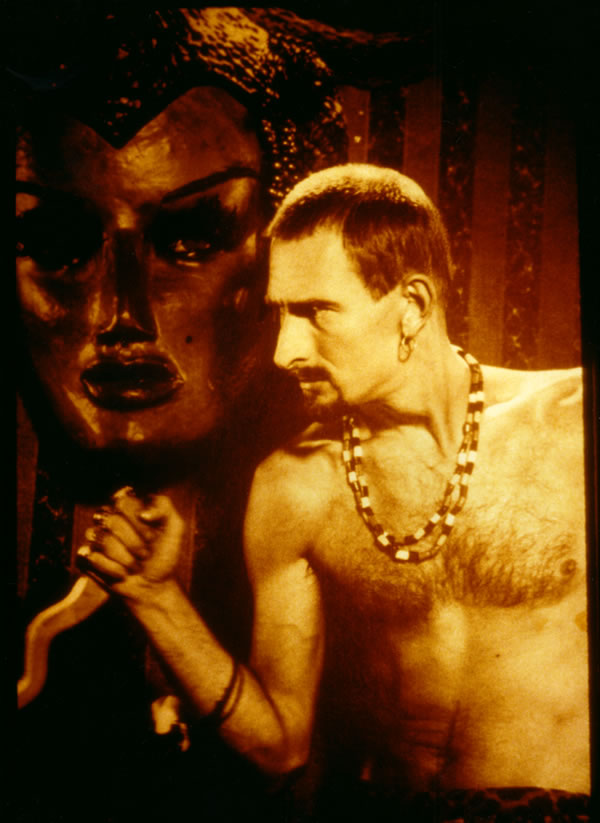

2006 / digital / color / 96min. (U.S.A.)
Jack Smith is simultaneously hailed as the godfather of performance art, a groundbreaking photographer and the “William Blake of film.” His utopian ideals, artistic processes and bejeweled artworks became essential influences to contemporary art superstars like Andy Warhol, Federico Fellini and Matthew Barney.
In her feature-length film debut, director Mary Jordan combines Smith’s rare and unseen films and photographs with rare audio recordings, acting appearances and other relics squeezed from Smith’s vaulted archives. Jordan also delves into Smith’s tenuous relationship with Andy Warhol – who adopted Smith’s ideas and actors in his own work (including Smith’s “Superstars” concept) – his vilification of New American cinema pioneer Jonas Mekas and other previously undocumented biographical topics.
This documentary portrait pays homage to New York’s ultimate antihero and the original King of the Underground.
Born in Ohio and arriving in New York in 1953, Smith transformed the detritus of post-war downtown New York into a tableaux vivant of exotic glamour and polysexual fantasy. In 1957 he opened the Hyperbole Photography Studio in which he photographed customers/models in compositions that were equal parts Rococo and Hollywood. Working on a shoe-string budget, Smith created an orgy of fantasy that transcended the all-too-pat bounds of camp and revolutionized American film. Upon seeing Flaming Creatures, Jonas MEKAS dubbed it the “most luxurious outpouring of imagination, of imagery, of poetry, of movie artistry.”
A key figure in the cultural history of Downtown New York film, performance, and art, Jack SMITH began producing work in the late 1950s and became one of the most accomplished and influential artists throughout the 1960s, 70s, and 80s. Smith’s method of weaving his life as a performance varied across media and glorified his exploits and adventures through the urban landscape wherein he developed an exuberant and visually stunning vision of the world from the glittering debris of the city, transforming downtown New York into a stage for his forays into photography and film. After a period of about eight years (1961-1969) in which Smith showed the films in their completed forms in conventional film screening settings, he began to incorporate the films and his slides into live performances that he himself named “Live Film.” He created startling stage effects through the spontaneous rearrangement and interplay of recorded imagery on film and slides, along with live action on a “stage,” editing and re-editing the film images in the midst of the performance. This spontaneous editing, however, required a unique form of splicing in which he assembled strands of camera original as well as printed material with masking tape. Thus, Smith managed to create a unique version of the films for each performance. Unlike his contemporaries in the underground film scene, Smith looked to Hollywood for his aesthetic models. In his writings he extolled the early Technicolor achievements of B-actress Maria Montez. Smith’s insubordinate aesthetics within the art scene were mirrored in his progressive politics: Smith formulated theories of popular socialistic thinking that he sought to enact in his work and life. Communal to the point of a celebratory chaos, the idea of the involuntary gesture, usually caused by a technical breakdown in his filmmaking, was melded to his theory of Art-as-Trash to create some of the most visually striking filmic episodes in American cinema.
Although in Jack SMITH’s lifetime he was much less celebrated than the many people he inspired, Smith’s multi-media influence is evident in the works of a broad segment of contemporary American art. In film, his influence is apparent in the work of his contemporaries, from Andy Warhol, Ken JACOBS, Kenneth Anger, Derek Jarman, and the Kuchar brothers, to contemporary artists such as Guy Maddin, Ryan Trecartin, and John Waters. Smith collaborated with a range of visual artists, frequently with Claus Oldenburg and Carolee SCHNEEMANN who created props for Smith’s films sets, which in turn inspired those artists toward new aesthetic trajectories within their own work. In avant-garde theater and performance art, Smith’s influence reaches Robert Wilson, Charles Ludlam, John Vaccaro, Cindy Sherman, John Bock and Richard Foreman.
Tokyo Park Tower:4/29 18:45
Tokyo Image Forum:5/5 21:05
Kyoto:5/18 14:30
Nagoya:6/18 16:30